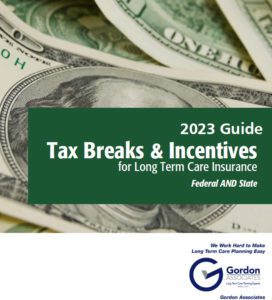According to researchers, something like 70% of Americans age 65 and older will require long term care at some point. Which means that the chances of needing long term care at some point in your life are quite high. But it probably doesn’t feel that way when you’re looking for a Long Term Care Insurance policy. You’re probably just thinking to yourself: is this something I’ll ever actually use?!
The best LTCI policies are those that are tailored to your lifestyle, your budget, your expectations, and unique needs.
It can be challenging–especially for younger individuals–to wrap your head around exactly what your LTCI policy might look like and how you’ll end up using it. That’s why seeing how other people–in a diverse set of circumstances–took full advantage of their Long Term Care Insurance might be useful.
Example Cases From Our Own Clients
Both of these example cases come directly from GALTCI’s own clients. We won’t be using the clients’ real names in order to protect their privacy (and their family’s privacy), but the details remain true.
Taking the “Long” in Long Term Care Seriously
Our first example comes from a woman (let’s call her Jane) who was in her early 70s when she purchased her Long Term Care Insurance. At first, she and her family initially wanted a plan that covered 4 years of benefits and offered a payout of $80 per day with a simple inflation rate of 5%.
But after looking at her lifestyle and her total retirement income (pension and Social Security), it would be better for her to have an additional source of lifetime income. After talking with her and her family, and evaluating what she could afford, Jane made the decision to switch to a plan with an unlimited period of benefits and a higher per day payout. Her new plan offered a $120 per day payout during an unlimited period.
This more robust policy ended up paying off. Jane started using her Long Term Care Insurance policy only three years later. And because she had moved to a larger and more robust policy, there was money leftover in her retirement to pass on as a legacy. Had Jane chosen the original policy, she would have collected about $144,000 in total benefits. However, she ended up collecting about $475,000 in benefits, and she never had to dip into her savings.
The larger policy came with a slightly larger price tag–but it meant that Jane could better afford her care in the long run. And that’s important to note. None of us can predict the future. But if you need to use your Long Term Care Insurance at any point, you’re going to want the best policy your budget can afford–especially if the benefits period is unlimited.
In other words, if you can afford a better policy–a policy more suited to your lifestyle and age–go with that one. Trying to save pennies on your premium can end up costing you more in the long run.
Eliminating the Elimination Period
Our next example is of a couple–an accountant and a school teacher (let’s call them Stan and Sue). Stan and Sue had purchased Long Term Care Insurance policies previously. Stan already required some assistance at home. Most of this care was provided by Sue. However, Sue required some surgery and the associated recovery meant that she would be unable to provide this care for a period of a few months.
With surgery pending, Sue called us to ask how her and Stan’s benefits would work. Could Stan be cared for at home while she was dealing with her surgery? Would the elimination period delay payment of benefits until after Sue could start taking care of Stan again? This elimination period could prove quite detrimental to Stan and Sue, largely because they knew they were going to need a significant amount of care right away.
Stan’s and Sue’s policies included a feature that could make the elimination period go faster. Their plans allowed for 1 visit a week = 7 days of credit toward the elimination period. Even 1 day of use, even just a few hours in some cases, counts as 1 week of elimination period. (Please note – whether you use 1 day in a week or 7 days in the week, it counts as 7 days of credit). Stan and Sue brought in part-time, in-home care for one 1 day per week for 13 weeks and spent under $1,500 in total–and successfully ate up their entire elimination period. This meant that Sue could undergo her surgery and feel comfortable in knowing that Stan would be taken care of–as would the cost of his care.
Finding the Right Plan for Your Needs
Both of these examples have something in common: the clients decided on plans that fit their needs. And, as a result, the payouts were even more beneficial. And while no one knows what the future will bring, you can make educated guesses based on your needs and your budget. (This is also something a financial planner or insurance broker can help with.)
Many Long Term Care Insurance plans offer flexibility and customizability in ways you might not predict. But the more you align your plan with your future, the better protected you’ll be.
Will You Use Your LTCI?
So, will you use your Long Term Care Insurance? As ever, the answer is: most likely. Stan, Sue, and Jane certainly did–and they’re a lot like the vast majority of our clients. With the right approach, you can ensure that your LTCI covers you when you need it most.
Want to talk to someone about your Long Term Care Insurance needs? Contact us today to schedule an appointment!


 To help determine if long-term care (LTC) insurance is right for you, we are offering a FREE informational guide. This is a comprehensive booklet that will answer many of your questions about tax breaks and incentives for LTCI for federal and state taxes.
To help determine if long-term care (LTC) insurance is right for you, we are offering a FREE informational guide. This is a comprehensive booklet that will answer many of your questions about tax breaks and incentives for LTCI for federal and state taxes. To help determine if long-term care (LTC) insurance is right for you, we are offering a FREE informational guide. This is a comprehensive booklet that will answer many of your questions about LTC and assist you with your health care planning.
To help determine if long-term care (LTC) insurance is right for you, we are offering a FREE informational guide. This is a comprehensive booklet that will answer many of your questions about LTC and assist you with your health care planning.